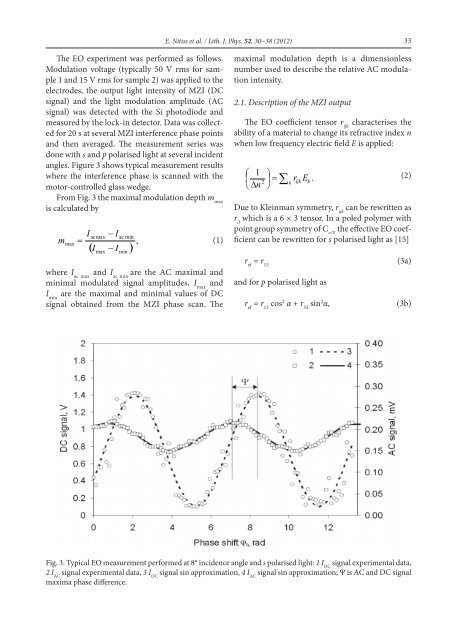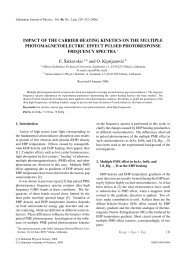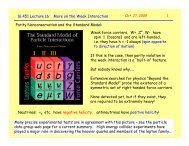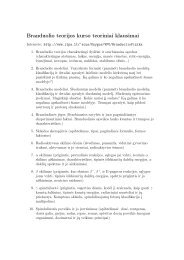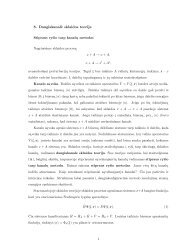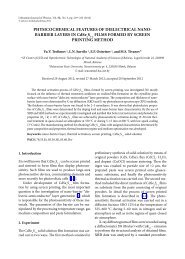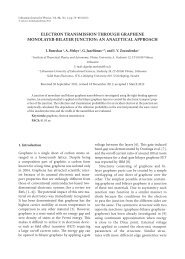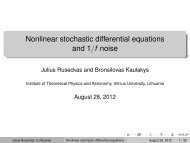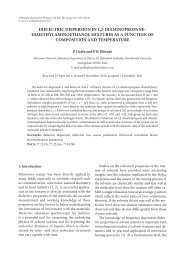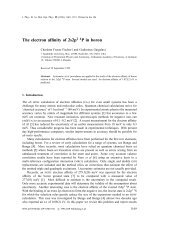effects of the multiple internal reflection and sample thickness ...
effects of the multiple internal reflection and sample thickness ...
effects of the multiple internal reflection and sample thickness ...
Create successful ePaper yourself
Turn your PDF publications into a flip-book with our unique Google optimized e-Paper software.
E. Nitiss et al. / Lith. J. Phys. 52, 30–38 (2012) 33<br />
The EO experiment was performed as follows.<br />
Modulation voltage (typically 50 V rms for <strong>sample</strong><br />
1 <strong>and</strong> 15 V rms for <strong>sample</strong> 2) was applied to <strong>the</strong><br />
electrodes, <strong>the</strong> output light intensity <strong>of</strong> MZI (DC<br />
signal) <strong>and</strong> <strong>the</strong> light modulation amplitude (AC<br />
signal) was detected with <strong>the</strong> Si photodiode <strong>and</strong><br />
measured by <strong>the</strong> lock-in detector. Data was collected<br />
for 20 s at several MZI interference phase points<br />
<strong>and</strong> <strong>the</strong>n averaged. The measurement series was<br />
done with s <strong>and</strong> p polarised light at several incident<br />
angles. Figure 3 shows typical measurement results<br />
where <strong>the</strong> interference phase is scanned with <strong>the</strong><br />
motor-controlled glass wedge.<br />
From Fig. 3 <strong>the</strong> maximal modulation depth m max<br />
is calculated by<br />
(1)<br />
maximal modulation depth is a dimensionless<br />
number used to describe <strong>the</strong> relative AC modulation<br />
intensity.<br />
2.1. Description <strong>of</strong> <strong>the</strong> MZI output<br />
The EO coefficient tensor r ijk<br />
characterises <strong>the</strong><br />
ability <strong>of</strong> a material to change its refractive index n<br />
when low frequency electric field E is applied:<br />
(2)<br />
Due to Kleinman symmetry, r ijk<br />
can be rewritten as<br />
r il<br />
which is a 6 × 3 tensor. In a poled polymer with<br />
point group symmetry <strong>of</strong> C ∞V<br />
<strong>the</strong> effective EO coefficient<br />
can be rewritten for s polarised light as [15]<br />
where I ac max<br />
<strong>and</strong> I ac min<br />
are <strong>the</strong> AC maximal <strong>and</strong><br />
minimal modulated signal amplitudes, I max<br />
<strong>and</strong><br />
I min<br />
are <strong>the</strong> maximal <strong>and</strong> minimal values <strong>of</strong> DC<br />
signal obtained from <strong>the</strong> MZI phase scan. The<br />
r ef<br />
= r 13<br />
<strong>and</strong> for p polarised light as<br />
r ef<br />
= r 13<br />
cos 2 α + r 33<br />
sin 2 α,<br />
(3a)<br />
(3b)<br />
Fig. 3. Typical EO measurement performed at 8° incidence angle <strong>and</strong> s polarised light: 1 I DC<br />
signal experimental data,<br />
2 I AC<br />
signal experimental data, 3 I DC<br />
signal sin approximation, 4 I AC<br />
signal sin approximation; Ψ is AC <strong>and</strong> DC signal<br />
maxima phase difference.


